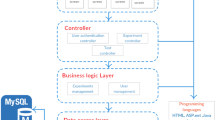Abstract
The possibilities of using virtual laboratories in the process of teaching physics at a university are discussed. Various scenarios for conducting classes in a virtual laboratory for both undergraduate students and masters are offered. The ways of expanding the subject and technical capabilities of the virtual laboratory are considered, methodical recommendations and their possible technical solutions are suggested.
Access this chapter
Tax calculation will be finalised at checkout
Purchases are for personal use only
Similar content being viewed by others
References
Stankova, E.N., et al.: The use of computer technology as a way to increase efficiency of teaching physics and other natural sciences. In: Gervasi, O., et al. (eds.) ICCSA 2016. LNCS, vol. 9789, pp. 581–594. Springer, Cham (2016). https://doi.org/10.1007/978-3-319-42089-9_41
Dyachenko, N.V., et al.: Prototype of informational infrastructure of a program instrumentation complex for carrying out a laboratory practicum on physics in a university. In: Gervasi, O., et al. (eds.) ICCSA 2017. LNCS, vol. 10408, pp. 412–427. Springer, Cham (2017). https://doi.org/10.1007/978-3-319-62404-4_30
Kostsov, V.V., Stankova, E.N.: Laboratory practical work using virtual stands on discipline “Physics”. Section “Molecular physics and thermodynamics”. RSHU, St. Petersburg (2010). - 64 p. (in Russian)
Trukhin, A.V.: On the use of virtual laboratories in education. Open Distance Educ. 4(8), 70–72 (2002)
Gorbachev, Yu.E., Zhmakin, A.I., Zatevakhin, M.A., Krzhizhanovskaya, V.V., Bogdanov, M.V., Kulik, A.V., Ofengheim, D.H., Ramm, M.S.: From electronic textbooks to virtual laboratories. Telecommunications and informatization of education 5(36) (2006). (in Russian)
Gorbachev, Yu.E., Krzhizhanovskaya, V.V., Bogdanov, M.V., Zhmakin, A.I., Kulik, A.V., Ramm, M.S.: Virtual laboratories - software complexes for science and education. In: Proceedings of the XIV All-Russian Scientific and Methodical Conference Telematika 2007, 18–21 June 2007, pp. 108–109. University telecommunications, St. Petersburg (2007). (in Russian)
Dyachenko, N.V., Dyachenko, V.K.: Method of calculation of parameters of the spray cloud surrounding the amphibious hovercraft (ASVP) when floating above the water surface in the collection of proceedings of TSNII im. Acad. A. N. Krylov “Modern computational methods in ship theory”, 49(333), 111–122 (2009). Publishing house of CRI to them. A. N. Krylov, St. Petersburg
Dyachenko, N.V., Anosov, V.N.: Calculation of the amount of water carried into the atmosphere by a jet of air from the airbag in the collection of works TSNII them. Acad. A. N. Krylov “Modern computational methods in ship theory”, 49(333), 123–134 (2009). Publishing house of CRI to them. A. N. Krylov, St. Petersburg
Dyachenko, N.V.: Dynamics of water droplets movement in the spray cloud surrounding the amphibious hovercraft (ASVP) in the lateral wind. Trudy TSNII im. Acad. A. N. Krylov. B. 59(343), 165–176 (2011)
Petrov, D.A., Stankova, E.N.: Use of consolidation technology for meteorological data processing. In: Murgante, B., et al. (eds.) ICCSA 2014. LNCS, vol. 8579, pp. 440–451. Springer, Cham (2014). https://doi.org/10.1007/978-3-319-09144-0_30
Stankova, E.N., Balakshiy, A.V., Petrov, D.A., Shorov, A.V., Korkhov, V.V.: Using technologies of OLAP and machine learning for validation of the numerical models of convective clouds. In: Gervasi, O., et al. (eds.) ICCSA 2016. LNCS, vol. 9788, pp. 463–472. Springer, Cham (2016). https://doi.org/10.1007/978-3-319-42111-7_36
Acknowledgment
This research was sponsored by the Russian Foundation for Basic Research under the projects: 16-07-01113 “Virtual supercomputer as a tool for solving complex problems”.
Author information
Authors and Affiliations
Corresponding author
Editor information
Editors and Affiliations
Rights and permissions
Copyright information
© 2018 Springer International Publishing AG, part of Springer Nature
About this paper
Cite this paper
Stankova, E.N., Dyachenko, N.V., Tibilova, G.S. (2018). Virtual Laboratories: Prospects for the Development of Techniques and Methods of Work. In: Gervasi, O., et al. Computational Science and Its Applications – ICCSA 2018. ICCSA 2018. Lecture Notes in Computer Science(), vol 10963. Springer, Cham. https://doi.org/10.1007/978-3-319-95171-3_1
Download citation
DOI: https://doi.org/10.1007/978-3-319-95171-3_1
Published:
Publisher Name: Springer, Cham
Print ISBN: 978-3-319-95170-6
Online ISBN: 978-3-319-95171-3
eBook Packages: Computer ScienceComputer Science (R0)




